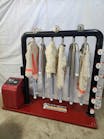A Case Study in Decontamination
Fire departments across the country are faced with a problem: deadly carcinogens and how best to remove them from personnel after a fire. The Eau Claire Fire Department in Wisconsin took this issue head on in the design of its new fire station. Leaders at the department wanted to protect their employees as well as themselves and took the time to address this important aspect of the building. Not only was the department dealing with the important topic of decontamination, but they were also challenged with constructing their new state-of-the-art facility on a contaminated site. Although challenging, the department and city went the extra mile and challenged the design team to come up with innovative solutions to these problems.
Starting with a vision
In 2017, the City of Eau Claire began the process of designing a new satellite station, replacing existing Fire Station No. 10 on the city’s East Side.
Our team used a comprehensive GIS study to review potential site locations, eventually selecting a densely vegetated lot in a residential area; however, the site was known to be a former waste disposal area in the early 1900s. Based on historic topographic maps, the team revealed that there was a ravine at the proposed site, which the locals used to fill with various materials. These materials were glass and paper-type products, which were then burnt off. Geo-technical data indicated that half of the station could be placed in the upper northwest corner of the property and still be located in virgin sand soils, while the other half of the station would need excavation to depths of 30 feet to remove these unsuitable materials.
A Phase 2 environmental site assessment indicated heightened levels of volatile organic compounds (VOCs). This resulted in our sub-consultant recommending that a passive vapor mitigation system be installed under the slab of the entire building footprint. Passive vapor mitigation systems consist of perforated PVC pipe strategically placed throughout the building, located under a vapor barrier membrane of the proper thickness and welded seams. Much like how a radon system removes radon gas from a home, vapor mitigation systems prevent harmful gases and other contaminants from entering the building by venting the under slab of a building through the roof of the facility.
Careful coordination occurred with the appropriate agencies to ensure that the final product the city and fire department were getting met all regulations. Use of this site took a blighted site and turned it into a well utilized piece of property, perfectly suited for the department in both size and location for response.
Designing with a purpose
The living quarters are complete with kitchen, dining, day and exercise rooms, as well as gender-neutral toilet/showers and six dorm rooms. The design also features a patio surrounded by planters outside of the dining area, with a grill that can be connected to station alerting. Separate pantries and refrigerators for different shifts, along with pass-through lockers from the hallway to the dorm rooms, remove interruptions during shift change while still providing access for staff to retrieve belongings while the dorms are occupied.
The new station includes five drive-through bays, of which two were bid as an alternate bid to the project, allowing the client to maximize the potential of their budget. The apparatus bay is complete with direct connect vehicle exhaust, in-floor heat, natural daylighting, parallel trench drains under the trucks and all of the proper utilities to the apparatus.
A mezzanine sits above the apparatus bay support area housing all of the mechanical equipment, noise-isolated SCBA compressor, additional gear storage and overall storage. Removable guardrails are provided throughout, allowing firefighters to be creative with potential training exercises in the station. The apparatus bay support area includes a maintenance room, SCBA work room, EMS storage and a state-of-the-art decontamination area.
Decontamination area
When designing the facility’s personnel decontamination area, the first consideration is the process. Think of this in the same manner a surgical suite would be designed, allowing a surgeon to go through a specific process to be sanitary before surgery. That precise procedure only works if the fire staff follow the design intent and not circumvent the system.
Many articles have been written in Firehouse discussing fire station zones, with the intent to keep carcinogens/contaminants contained to specific areas. Although still an unknown science, trying to remove these contaminants from the firefighter’s own body is one of the highest priorities. Keeping contaminants from reaching the living quarters of a fire station or even the home of a firefighter is best practice.
As Diagram 1 shows, the flow of the Eau Claire Fire Station No. 10’s decontamination area is the key as well as the tools that reside in those various areas. Essentially, a firefighter will travel from the hot zone to the transition zone and then finally the cold zone of the fire department, again following the process.
The decontamination design focuses exclusively on the transition area of the fire station. After returning to the station and entering the apparatus bay, or the hot zone, firefighters take all contaminated gear and equipment from the apparatus to the beginning of the transition zone. Transition zone areas/rooms typically consist of very durable finishes, such as concrete block walls with epoxy paint finishes for the ability to properly clean them. Fluid-applied epoxy floor finishes with integral coved base up the walls a minimum of 6 inches make the floor an easy wash. Ceilings of exposed structure or ceiling tiles with washable vinyl surfaces can be used as well. Ample lighting allows for proper cleaning of the space and equipment.
Personnel will first enter the gear laundry area directly off the apparatus bay. The breakdown of PPE and specific equipment begins, and the cleanup of those items is handled in this space. A deep double-basin stainless-steel sink with train boards and on pedestals, similar to something you would see in a commercial kitchen, sits immediately in the room as well as a floor sink large enough to wash items of significant size. A floor-mounted wash extractor is provided with the proper foundation/curb and trench behind it for draining. Some stations install specific PPE gear dryers that can also dry hose, which also require venting directly to the exterior of the facility. Other components in this space are an electric hand dryer, eye/emergency shower, a steam shower boiler unit, and miscellaneous metal cabinetry for storage of various cleaning supplies/agents.
Directly flanking the gear laundry area is the gear PPE storage room. It is important to have access to this room from gear laundry to easily put away the PPE gear after it has gone through the cleaning process, but it also must have access directly to the apparatus bay for obvious reasons. This room will contain some method of storing gear, of which there are many options, and it seems that every department has their preferred favorites. Be sure to review all the options that these manufacturers offer and pick the right size storage locker that will work for you. This room would also have dedicated exhaust, abundant floor/trench drains and ceiling fans to keep air moving, and again, plenty of lighting.
As you move through the process, you enter the decontamination hall. Although you have already left your PPE gear back in the gear storage, it has become a common concern of those in the industry that the firefighters themselves still have an abundant amount of cancer-causing agents on their body and on the uniforms under their PPE. In the decontamination hall, there is a set of small lockers, one for each individual of the department. These lockers hold a change of clothing that department members then take into the decontamination shower/toilet rooms.
The design of the decontamination shower/toilet areas is focused on finding the best way to get firefighters completely decontaminated. Depending on the size of the department, two of these spaces may not be enough. As a matter of fact, we currently have four of these decontamination areas under design or construction, and have gone up to four decontamination shower/toilet rooms in some volunteer/combination departments.
The decontamination shower/toilet areas are essentially gender-neutral single-occupant rooms, similar to what you would see in a family home. Each space is full of durable, cleanable and high-quality products. Wall-mounted sinks, flush-valve toilets and storage cabinets for bathroom essentials and towels are a must. Each of these spaces contains walk-in showers that also serve as steam showers. The theory behind the dual use is for personnel to either take a shower, a steam shower to detoxify or to simply do both. The rationale is to take a shower to open the pores, take a steam shower to detoxify, and then be able to rinse the sweat and toxins from your body.
The other options for decontamination include an infrared or dry sauna where one could be clothed and then make their way to the shower. Is there a right answer to the dry sauna versus wet sauna debate? The opinions tend to be all over the map. Dry saunas tend to be better for relaxing muscle and lowering blood pressure, but steam rooms will help with overall detoxification of the body. Again, I stress that fire departments at least be proactive and try to incorporate one or the other in their facilities.
Once finished in the decontamination toilet/shower rooms, staff then take their uniforms to the living quarters or clean laundry area. This room consists of residential dryer and washing machines, a laundry tub, cabinets for storage and a floor sink. The room also doubles as a janitor’s closet, which is large enough to hold all supplies and equipment to clean the entire station from top to bottom. This clean laundry area serves as the end of the transition zone and allows you to enter the cold zone or living quarters as decontaminated as one could be and ready to respond to the next emergency.
A new home
The Eau Claire Fire Department moved into their new station in July 2018. They now have a state-of-the-art fire station that not only meets their response time and space needs, but also meets the needs of maintaining their own health now and into the future.
Robert Krzyzanowski
Robert Krzyzanowski is the director of emergency services for Wendel, home of Five Bugles Design, for which he oversees all emergency services design projects throughout the Midwest, and assists on design throughout the country for all 15 Wendel offices. He has almost 20 years of experience working on public projects, and has been involved in more than 25 fire station projects in the last three years and more than 65 in his career.






